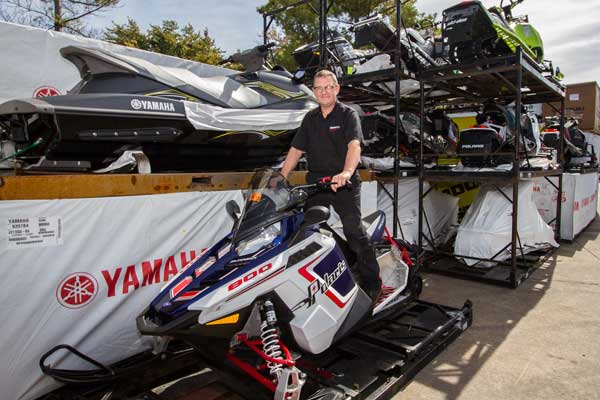While the average person may cringe at the approach of another intense Midwest winter, for avid snowmobilers the change in seasons means it’s time dust off their machines and get ready to hit the trails.
Dan Cunningham, the shop foreman at Honda East in Maumee, has been snowmobiling since he was 12 years old. He says this past winter was a banner year for snowmobiling.

Snowmobiles can sustain more damage while stored over the summer than in use during the winter, said Dan Cunningham, shop foreman at Honda East in Maumee. Toledo Free Press photo by Christie Materni
“You could go back 30 years and not find a better winter for snowmobiling than we had last year,” Cunningham said.
Consistent snow cover on the lower Michigan peninsula meant it was a popular year to start snowmobiling, and while more snow means less wear on the machine, it also means more activity, making proper maintenance vital as the region gears up for what could be another heavy winter.
“The biggest thing is fuel,” he said. “Drain any excess fuel, put in fresh fuel, check the fuel gauge and replace it if necessary.”
It is also important to check high-maintenance parts like clutches and drive belts.
Sam Black, co-owner of DZ Motorsports in Genoa, recommended stocking up on an extra drive belt at the beginning of the season to avoid being stranded if your first part breaks.
Cunningham also suggested making sure riders replace ski wear rods and the plastic hyfax that cover them.
If proper preventative maintenance was performed at the end of last season, these routine checks should be all you need to get your snowmobile back out on the trails, both men said.
“The key is to maintain a snowmobile properly before it’s put away,” Cunningham said, “More damage happens when they’re sitting in storage than when they’re actually operating.”
This means that before putting the machines in storage, conscientious snowmobile owners would have drained the engine of fuel to prevent buildup of gooey “varnish,” “fogged” or coated the engine with oil, removed the battery and the drive belt and cleaned the machine thoroughly to prevent salt buildup from causing corrosion.
“Once the snow melts, sometimes people just park it in the garage and don’t worry until fall,” Black said. “Then it sits all summer and can become a big pile of corrosion and rust.”
Vehicle maintenance
Of course, while snowmobilers are waiting eagerly for winter to arrive, most automobile owners are dreading the slippery, snowy roads and the unpredictable weather of the Great Lakes region.
However, a few simple steps can save drivers a lot of worry in the winter months, area experts said.
Bob Kazmierczak, enterprise development manager and vice president of automotive services at AAA Northwest Ohio, said aside from cars getting stuck in heavy snow, batteries dying suddenly tops the list of the light maintenance calls AAA gets during the winter.
“It’s the same as getting gas. People don’t wait until they run out of gas to get more, but for some reason people tend to wait until their battery dies before they worry about it,” Kazmierczak said.
The average car battery lasts around four years, and changing it before it dies can help drivers avoid dangerous situations.
Even the most meticulous driver can be caught off guard by winter conditions, so if drivers do find themselves stranded on the roads this winter, Kazmierczak recommended keeping a blanket or extra coat, a small shovel, a first aid kit, a bag of rock salt, a flashlight, water and a granola bar in the car. He also recommended keeping a candle and matches, which can provide both heat and light until help arrives.
Checking the tires’ tread and all fluids, including oil, transmission fluid and coolant, is also recommended.
“Coolant fluids actually will keep the engine from icing up and will provide heat inside the car, so make sure you have enough of that,” Kaz-mierczak said.
A general inspection of the vehicle by a mechanic, especially to check steering, brakes and suspension, is always a good idea, Kazmierczak said.
“We get a lot of potholes as a result of the weather and the salt on the roads really tears up the suspension, so you’ll have less problems at the end of the winter if you start out with everything in good condition,” he said. O



